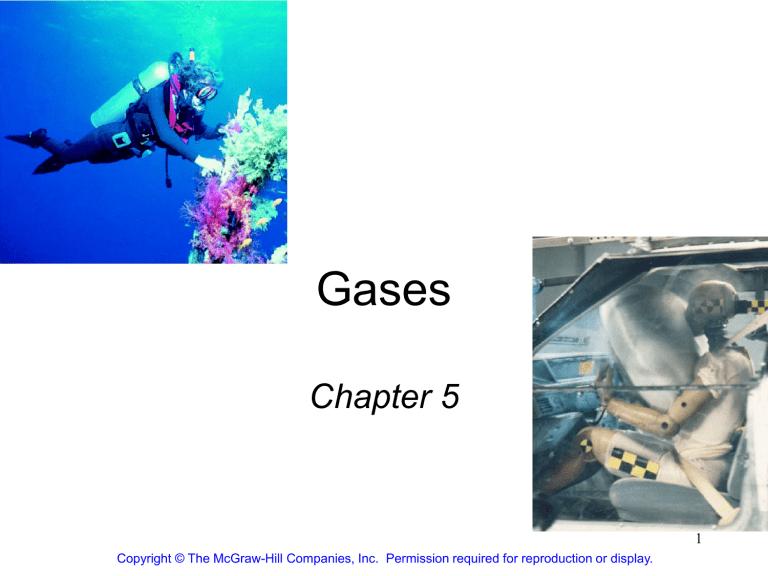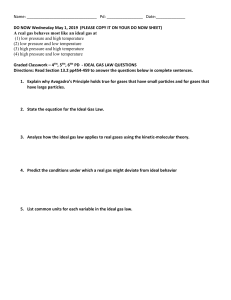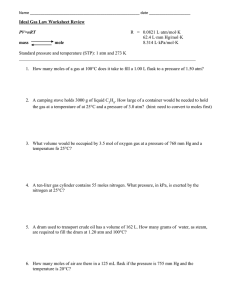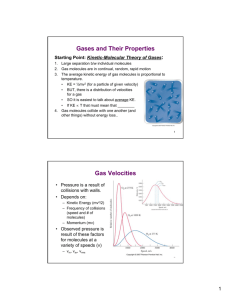Gases: Gas Laws, Ideal Gas Equation, Kinetic Theory
advertisement

Gases Chapter 5 1 Copyright © The McGraw-Hill Companies, Inc. Permission required for reproduction or display. Elements that exist as gases at 250C and 1 atmosphere 2 3 Physical Characteristics of Gases Gases assume the volume and shape of their containers. Gases are the most compressible state of matter. Gases will mix evenly and completely when confined to the same container. Gases have much lower densities than liquids and solids. NO2 gas 4 Pressure of a Gases Force Pressure = Area (force = mass x acceleration) Units of Pressure 1 pascal (Pa) = 1 N/m2 1 atm = 760 mmHg = 760 torr 1 atm = 101,325 Pa 5 Atmospheric Pressure 10 miles 4 miles Sea level 0.2 atm 0.5 atm 1 atm 6 Manometers Used to Measure Gas Pressures closed-tube open-tube 7 Pressure-Volume relationship: Boyles Law Robert Boyle (1627 – 1691). British chemist and natural philosopher. Wrote the book “The Skeptical Chymist (1661)” influenced generation of chemists. 8 Apparatus for Studying the Relationship Between Pressure and Volume of a Gas As P (h) increases V decreases 9 Boyle’s Law P a 1/V P x V = constant P1 x V1 = P2 x V2 Constant temperature Constant amount of gas 10 A sample of chlorine gas occupies a volume of 946 mL at a pressure of 726 mmHg. What is the pressure of the gas (in mmHg) if the volume is reduced at constant temperature to 154 mL? P x V = constant P1 x V1 = P2 x V2 P2 = P1 = 726 mmHg P2 = ? V1 = 946 mL V2 = 154 mL P1 x V1 V2 726 mmHg x 946 mL = = 4460 mmHg 154 mL 11 Temperature-Volume Relationship: Charle’s and Gay-Lussac’s Law Jacques Alexandre Cesar Charles (1746 – 1823). French physicist. He was a gifted lecturer, an inventor of scientific apparatus and the first person to use hydrogen to inflate balloons. 12 Temperature-Volume Relationship: Charle’s and Gay-Lussac’s Law Joseph Louis GayLussac (1778 – 1850). French chemist and physicist. He was a balloon enthusiast. Once he ascended to an altitude of 20,000 ft to collect air samples for analysis. 13 Variation in Gas Volume with Temperature at Constant Pressure As T increases V increases 14 Variation of Gas Volume with Temperature at Constant Pressure Charles’ & Gay-Lussac’s Law VaT V = constant x T V1/T1 = V2 /T2 Temperature must be in Kelvin T (K) = t (0C) + 273.15 15 A sample of carbon monoxide gas occupies 3.20 L at 125 0C. At what temperature will the gas occupy a volume of 1.54 L if the pressure remains constant? V1 /T1 = V2 /T2 V1 = 3.20 L V2 = 1.54 L T1 = 398.15 K T2 = ? T1 = 125 (0C) + 273.15 (K) = 398.15 K T2 = V2 x T1 V1 = 1.54 L x 398.15 K 3.20 L = 192 K 17 Volume-Amount Relationship: Avogadro’s Law Amedeo Avogadro (1776 – 1856). Italian mathematical physicist. His most famous work, now known as Avogadro’s law, was largely ignored his lifetime. 18 Avogadro’s Law V a number of moles (n) V = constant x n Constant temperature Constant pressure V1 / n1 = V2 / n2 19 Ammonia burns in oxygen to form nitric oxide (NO) and water vapor. How many volumes of NO are obtained from one volume of ammonia at the same temperature and pressure? 4NH3 + 5O2 1 mole NH3 4NO + 6H2O 1 mole NO At constant T and P 1 volume NH3 1 volume NO 20 Summary of Gas Laws Boyle’s Law 21 Charles Law 22 Avogadro’s Law 23 Ideal Gas Equation Boyle’s law: V a 1 (at constant n and T) P Charles’ law: V a T (at constant n and P) Avogadro’s law: V a n (at constant P and T) Va nT P V = constant x nT P =R nT P R is the gas constant PV = nRT 24 The conditions 00C and 1 atm are called standard temperature and pressure (STP). Experiments show that at STP, 1 mole of an ideal gas occupies 22.414 L. PV = nRT (1 atm)(22.414L) PV R= = nT (1 mol)(273.15 K) R = 0.082057 L • atm / (mol • K) 25 What is the volume (in liters) occupied by 49.8 g of HCl at STP? T = 0 0C = 273.15 K PV = nRT V= nRT P P = 1 atm 1 mol HCl n = 49.8 g x = 1.37 mol 36.45 g HCl 1.37 mol x 0.0821 V= L•atm mol•K x 273.15 K 1 atm V = 30.7 L 26 Density (d) Calculations P n PV = nRT, = V RT m Again, n = M m is the mass of the gas in g, M is the molar mass of the gas P = VM RT m PM m d= = V RT Molar Mass (M ) of a Gaseous Substance dRT M= P d is the density of the gas in g/L 28 A 2.10-L vessel contains 4.65 g of a gas at 1.00 atm and 27.0 0C. What is the molar mass of the gas? dRT M= P M= g 2.21 L 4.65 g m = = 2.21 d= 2.10 L V x 0.0821 L•atm mol•K g L x 300.15 K 1 atm M = 54.5 g/mol 29 Gas Stoichiometry What is the volume of CO2 produced at 37oC and 1.00 atm when 5.60 g of glucose are used up in the reaction: C6H12O6 (s) + 6O2 (g) g C6H12O6 5.60 g C6H12O6 x V= nRT = P mol C6H12O6 6CO2 (g) + 6H2O (l) mol CO2 V CO2 6 mol CO2 1 mol C6H12O6 x = 0.187 mol CO2 180 g C6H12O6 1 mol C6H12O6 L•atm x 310.15 K mol•K 1.00 atm 0.187 mol x 0.0821 = 4.76 L 30 Dalton’s Law of Partial Pressures V and T are constant P1 P2 Ptotal = P1 + P2 31 Consider a case in which two gases, A and B, are in a container of volume V. nART PA = V nA is the number of moles of A nBRT PB = V nB is the number of moles of B nA RT nBRT RT nRT PT PA PB (nA nB ) V V V V where n, the total no of moles; n = nA + nB, and PA, PB are partial pressures of gases A and B. Total pressure of a mixture of a gas depends on the total number of moles of gas, not on the nature of the gas. 32 In general, total pressure of a mixture of a gases, PT P1 P2 P3 where P1, P2, P3, … are the partial pressure of the components1, 2, 3, … To see how each partial pressure is related to the total pressure, consider a mixture of gases A and B. PA nA RT / V nA XA PT (nA nB )RT / V nA nB where XA is mole fraction of A. The mole fraction is a dimensionless quantity that expresses the ratio of the number of moles of one component to the number of moles of all components present. The mole fraction ni of component i in a mixture, Xi nT 33 So the partial pressures of A and B, PA = XA PT PB = XB PT The sum of the mole fractions for a mixture of gases must be unity. If two components are present, nA nB X A XB 1 nA nB nA nB If a system contains more than two gases, Pi = Xi PT mole fraction (Xi ) = ni nT From mole fractions and total pressure, we can calculate the partial pressures of individual components. 34 A sample of natural gas contains 8.24 moles of CH4, 0.421 moles of C2H6, and 0.116 moles of C3H8. If the total pressure of the gases is 1.37 atm, what is the partial pressure of propane (C3H8)? Pi = Xi PT PT = 1.37 atm 0.116 Xpropane = 8.24 + 0.421 + 0.116 = 0.0132 Ppropane = 0.0132 x 1.37 atm = 0.0181 atm 35 Collecting a Gas over Water 2KClO3 (s) 2KCl (s) + 3O2 (g) PT = PO2 + PH2 O 36 Vapor of Water and Temperature 37 Kinetic Molecular Theory of Gases 1. A gas is composed of molecules that are separated from each other by distances far greater than their own dimensions. The molecules can be considered to be points; that is, they possess mass but have negligible volume. 2. Gas molecules are in constant motion in random directions, and they frequently collide with one another. Collisions among molecules are perfectly elastic. 3. Gas molecules exert neither attractive nor repulsive forces on one another. 39 Kinetic Molecular Theory of Gases 4. The average kinetic energy of the molecules is proportional to the temperature of the gas in kelvins. Any two gases at the same temperature will have the same average kinetic energy KE = ½ mu2 where, m = mass of the molecule, u = speed, and u 2 = mean square speed, it is the average of the square of the speeds of all the molecules: 2 2 2 u u u 2 N u2 1 N Assumption 4 enables us to write, 1 1 2 KE T , mu T , mu 2 CT 2 2 The absolute temperature of a gas is a measure of the random motion of the molecules. 40 Kinetic theory of gases and … Compressibility of Gases Boyle’s Law P a collision rate with wall Collision rate a number density (no. of objects/unit volume) Number density a 1/V P a 1/V Charles’ Law P a collision rate with wall Collision rate a average kinetic energy of gas molecules Average kinetic energy a T PaT 41 Kinetic theory of gases and … Avogadro’s Law P a density and mass of a gas, P a (n/V)T , [m a n] For two gases, P1 a (n1/V1)T1 = C (n1/V1)T1 P2 a (n2/V2)T2 = C (n2/V2)T2 where C = contant, when P1 = P2, T1 = T2, and V1 = V2 n1 = n2 Dalton’s Law of Partial Pressures Molecules do not attract or repel one another P exerted by one type of molecule is unaffected by the presence of another gas Ptotal = SPi 42 Apparatus for Studying Molecular Speed Distributiona 43 The distribution of speeds of three different gases at the same temperature The distribution of speeds for nitrogen gas molecules at three different temperatures u urms 2 3RT M 44 Calculate the root-mean-square speed of an O2 molecule at room temperature(20°C or 273 K). 45 Gas diffusion is the gradual mixing of molecules of one gas with molecules of another by virtue of their kinetic properties. r1 r2 = M2 M1 molecular path NH4Cl NH3 17 g/mol HCl 36 g/mol 47 Gas effusion is the process by which gas under pressure escapes from one compartment of a container to another by passing through a small opening. r1 r2 = t2 t1 = M2 M1 Nickel forms a gaseous compound of the formula Ni(CO)x. What is the value of x given that under the same conditions methane (CH4) effuses 3.3 times faster than the compound? r1 2 x M1 = (3.3)2 x 16 = 174.2 r1 = 3.3 x r2 M2 = r2 x = 4.1 ~ 4 48 M1 = 16 g/mol 58.7 + x • 28 = 174.2 ( ) Deviations from Ideal Behavior 1 mole of ideal gas PV = nRT PV = 1.0 n= RT Repulsive Forces Attractive Forces 49 Effect of intermolecular forces on the pressure exerted by a gas. 50 Van der Waals equation nonideal gas an 2 Pideal = Preal + 2 V Videal = Vreal − nb 2 an ( P + V2 ) (V – nb) = nRT } } corrected pressure corrected volume 51






